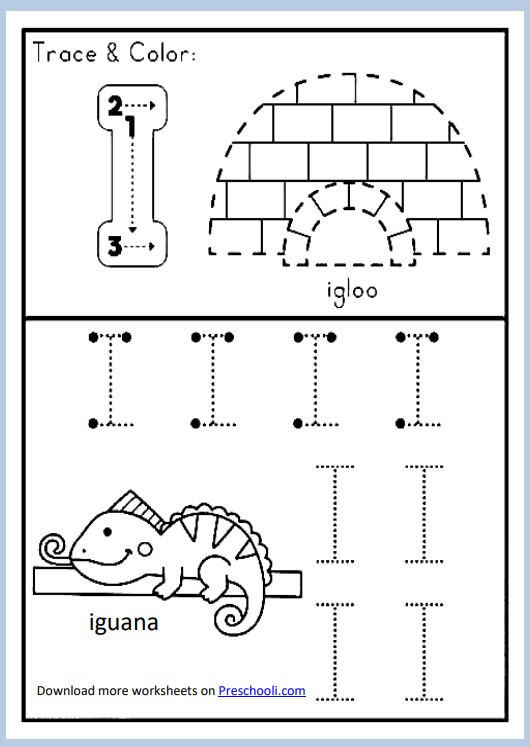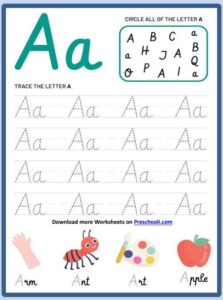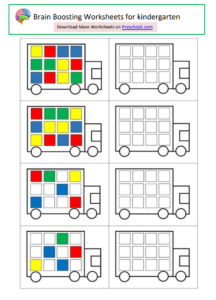Mastering the ‘I’: The Ultimate Guide to Letter ‘I’ Tracing Worksheets
Learning the alphabet is one of the most foundational experiences in early education. Letter ‘I’ tracing worksheets are an invaluable tool in preschool education, providing a tactile and visual way for children to begin mastering one of the 26 letters that are the building blocks of language.
This comprehensive blog post will serve as a beacon for parents, early educators, and homeschoolers, offering a deep understanding of how to utilize letter ‘I’ tracing worksheets effectively and engagingly. The end goal is to equip young learners with the skills and confidence they need as they take their first steps into literacy.
Why Start with Letter ‘I’ Tracing Worksheets?
The letter ‘I’ holds a special place in the alphabet, not just because it’s the ninth letter but because of its unique shape and sound. With its straight line and a dot, ‘I’ is often one of the easiest letters for children to recognize and trace. Beginning with such a letter helps build early confidence in writing skills and sets the stage for the more complex letters to come.
The Fundamental Approach
Preschool education champions stimulus-based learning. Every worksheet, every creative activity, and every play time is a structured yet explorative environment where children learn by doing.
The Cognitive and Motor Benefits
Fine motor skills lay a foundation for various everyday tasks such as tying shoelaces, writing, or using scissors. Tracing activities fine-tune these skills in children. The cognitive benefit is equally profound, as it sharpens letter recognition and reinforces phonetic associations.
Choosing the Right Letter ‘I’ Tracing Worksheet
Variety is key when it comes to selecting the right worksheets. Fun and engaging designs not only capture kids’ attention but also reflect their current interests, making the learning experience relatable and enjoyable.
Visual Engagement Through Themes
From ice creams to igloos, integrating such themes into the worksheet can turn a simple tracing exercise into an adventure, where children can associate the letter ‘I’ with familiar objects.
Skill-Level Tailored Worksheets
Every child is unique, and so is their learning pace. A good set of worksheets should progress from simple tracing lines to shapes, to actual letters, accommodating a range of skill levels.
Implementing Letter ‘I’ Tracing Worksheets in Lessons
The most efficient way to introduce letter ‘I’ tracing worksheets is by embedding them in a larger framework of activities that reinforce the letter’s form and sound.
Daily Alphabet Routines
Devote a few minutes each day to ‘I’ exercises, ensuring this practice becomes a fun, regular part of the routine rather than an isolated event.
‘I’ for Interactive Learning
Turn the worksheet session into a communication and creativity platform, where games, interactions, and questions about ‘I’ objects can enhance the learning environment.
Reinforcing Tracing Skills Outside the Worksheet
Learning doesn’t stop when the worksheet is put away. There are numerous opportunities throughout the day to reinforce and practice tracing skills.
Incorporating Physical Materials
Utilize a mix of physical and digital materials to teach tracing, such as drawing in the sand, using a whiteboard, or even tracing ‘I’ shaped cookies with icing.
Movement While Learning
Incorporate letter-themed movements during tracing exercises, where children can mimic the shape of ‘I’ with their bodies, making the letter a truly kinesthetic learning experience.
Monitoring Progress and Providing Feedback
Assessment and feedback are integral components of education, even at the preschool level. They help track a child’s progress and provide the necessary encouragement or redirection.
Keeping Track of Improvements
Documenting traced letters, noting the neatness and consistency of the tracing, and observing the child’s comfort level during the exercise gives a clear picture of how they’re improving.
Encouraging and Redirecting
Positive reinforcement is a powerful tool. Praise the effort and improvements, and gently redirect any errors or misconceptions. The aim is to create a supportive and enriching learning environment.
Integrating Technology with Tracing
In the digital age, technology can be an ally in the classroom. It can provide a colorful and interactive platform for letter tracing exercises.
Interactive Apps and Programs
Explore educational apps and programs that engage children with interactive letter ‘I’ tracing experiences, offering feedback and fun challenges to keep learning dynamic.
Balancing Screen Time
While technology is an aid, it is crucial to maintain a balance with traditional learning methods. Use technology as a supplement rather than a replacement for hands-on activities.
Making Letter ‘I’ Tracing a Family Affair
Engaging family members in a child’s learning journey can be both supportive and inclusive. It creates a continuum of learning between home and school environments.
Family Involvement Strategies
Create letter ‘I’ tracing activities that can be easily shared with family members, fostering collaborative learning and reinforcing the letter’s understanding in multiple settings.
Celebrating Milestones Together
Family support is instrumental in a child’s educational growth. Plan to celebrate ‘I’ milestones by showcasing traced letters on the refrigerator or quizzing family members on ‘I’ words and sounds.
Letter ‘I’ Tracing Worksheets in the Multicultural Classroom
The modern classroom is a tapestry of cultures. It’s important to incorporate diverse and inclusive materials that reflect the experiences of all learners.
Multicultural Themes in Worksheets
Choose ‘I’ tracing worksheet themes that appeal to various cultures, ensuring the worksheet content is relatable and respectful.
Learning from Each Other
Encourage students to share words and objects from their cultures that start with the letter ‘I’. This sharing not only broadens everyone’s horizons but can also teach tolerance and inclusivity.
Overcoming Challenges in Utilizing Letter ‘I’ Tracing Worksheets
While the benefits of letter ‘I’ tracing worksheets are myriad, educators may encounter challenges. Addressing these proactively ensures a smooth learning experience for all.
Addressing Disinterest
If disinterest is detected, reevaluate the selection of the worksheets. Sometimes a change in approach, design, or theme can make the tracing exercise engaging once again.
Ensuring Accessibility and Materials
Not all educational institutions have the same resources. Work collaboratively to ensure that all children have access to the necessary materials, from worksheets to writing tools.
Conclusion: The Power of ‘I’ in Early Education
Letter ‘I’ tracing worksheets are more than just teaching tools. They represent the first step in a child’s exciting literacy adventure. By making the learning process dynamic, inclusive, and enjoyable, we not only help children learn to write the letter ‘I’ but also imbue in them a love for learning that will last a lifetime.
Preschool parents, educators, and caretakers, the road ahead is as exciting as it is essential. It’s our shared responsibility to make letter ‘I’ tracing not just a lesson, but a landmark in the educational development of our youngest learners. Through creativity, inclusivity, and adaptability, we can ensure that each child’s exploration of the alphabet is as rich and rewarding as the ‘I’ itself.
Join our Facebook Group



